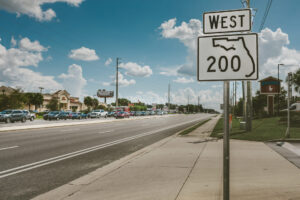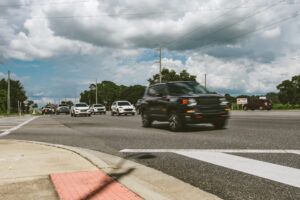
Marion County is facing $1.3 billion in road and public safety needs over next 20 years
When Marion County voters approved a one percent local option sales tax in 2016 to help pay for road and public safety needs, the referendum called for the tax to expire in four years. When the four-year tax expired, voters responded by renewing it for another four years.
That tax, which over the past eight years has generated about $500 million is about to expire again. The Marion County Commission is asking voters to approve the tax on the November general election ballot.
Except this time, they will be asking that the one cent tax be approved for 20 years.
County Commission Chairman Michelle Stone said the reason for the expanded timeframe is to allow county government officials to better plan road projects. Because they have learned that road projects often take a decade or more from inception to completion, commissioners believe a longer lifespan for the tax will be beneficial.
As it stands, the county says there are $1.3 billion worth of transportation and public safety projects that need addressing over the next 20 years, and the sales tax is the only way to pay for them, short of a steep hike in property taxes.
Since the first one cent tax won voter approval in 2016, the county has spent $261million on 39 road projects and $177 million on public safety equipment and facilities. Among the things the sales tax money funded:
5 new or remodeled fire stations
500-plus new sheriff’s patrol cars
4 new fire trucks, 2 ladder trucks, 2 new water tankers and 17 new ambulances
2 new Sheriff’s Office helicopters
319 new bullet-proof vests
319 new firefighter air packs
A new Animal Services facility
Improvements to the jail and communications center
39 road construction projects, most of which are resurfacing or widening.
(For a complete list of projects, go online to marionsalestax.org)

Initially, county officials told voters they just needed help recovering from the financial setbacks of the Great Recession. Yes, Marion County was growing, but at a manageable rate. During the recession, however, the county had fallen behind on road maintenance and construction and the public safety agencies – Fire Rescue and the Sheriff’s Office – were woefully behind on replacing outdated and worn-out vehicles.
The tax passed because the sheriff needed patrol cars, Fire Rescue needed ambulances and fire trucks and the roads were desperately in need of work.
With the newfound revenue stream, the various recipient agencies went to work filling their needs. The sheriff bought cars. The fire chief bought fire trucks. But the county engineer, at the time Tracy Straub, found that not only was the process of building new roads or expanding existing ones time-consuming than she expected, but the cost of right-of-way was also going up — rapidly. She tried negotiating, but said the result was not lower costs but higher prices.
“I just lost the ability to get out the door because I was negotiating the value,” said Straub, who is now assistant county administrator for public works and growth management.
Not only did land costs cause sticker shock at the McPherson Complex, road-building material costs started going steadily up as well, further increasing project costs. Compounding the problem is declining state gas tax revenues, she added.
“The overall cost of a project – the land costs being only one part of it – are going up, so we’re losing ground,” she said.
The other problem is the length of time it takes to get a major road project done. Stone and Straub used the four-laning of Southwest 80th Avenue, which runs along the World Equestrian Center from State Road 40 to U.S. 27, as an example.
The project was started in 2017. It involves multiple landowners and multiple public hearings at various stages of the project, so, now in 2024, Straub anticipates it will take another five years to complete.
Commissioner Craig Curry said that the growth Marion County is experiencing – an estimated 269 new residents every week – has made keeping up next to impossible. The growth has been especially impactful since 2020, with the end of the pandemic and the opening of WEC, exacerbating an already desperate the need for new roads.
“If you look where we’ve come from … since 2020, when I joined the commission, we’re at about 3-4 percent (annual) growth,” he said. “We saw mass migration. So, trying to stay ahead of that is really difficult.”
The 20-year sales tax referendum that will appear on the November ballot would generate about $1.4 billion, county officials estimate. About $962 million of that is tentatively earmarked for transportation projects and $338 million is targeted for public safety needs. One thing about a local option sales tax is that it cannot be spent on recurring costs, just one-time infrastructure or equipment expenditures.
Both Stone and Curry said if the tax fails, the county will be in a difficult predicament.
“The one-cent sales tax has allowed us to provide for projects that we would have been able to do otherwise,” Stone said. “Without it many, many projects just would not be done.
Curry noted the county has been able to keep property taxes relatively low due to the sales tax. Last year, he said, Marion County ranked 59th out of 67 counties in Florida in its property tax rate.
“The only thing holding down ad valorem taxes is the sales tax,” he said.
Curry added that Sheriff Billy Woods has asked for $4 million this year to buy new vehicles. Without the sales tax, the commissioner said, Woods is unlikely to get them.
“If we don’t have the sales tax, it’s not just going to affect roads.”
Currently, 26 other Florida counties have a local option one-percent sales tax. The four-year version Marion County has had is the shortest timeframe among the 27 counties with such a tax.






